Late Antique and Medieval Fortress in Ahtopol – City of Love and Happiness Agatopolis
- Stefan Ivanov

- Aug 3
- 15 min read
Quo vadis, Ahtopol?
How long will you travel back in time, Ahtopol? - exclaimed the world-famous Bulgarian archaeologist Prof. Velizar Velkov, speaking about the incredible discoveries from the underwater sea expedition conducted in 1983 near Ahtopol.
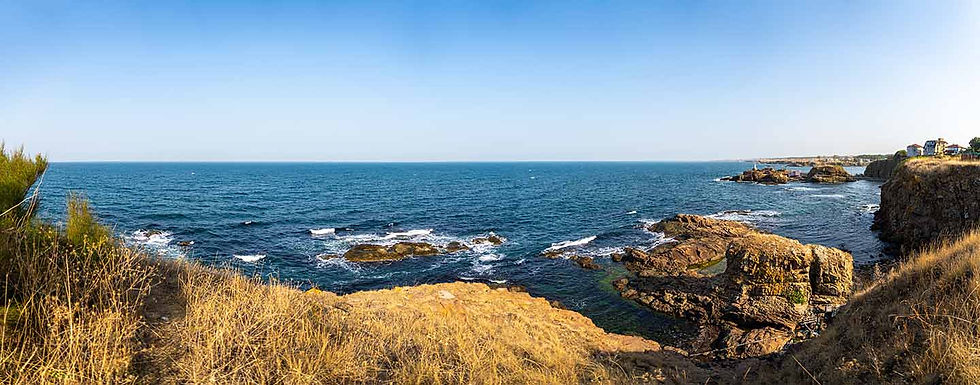
Ahtopol, located on the picturesque Bulgarian Black Sea coast, is a city with an extremely rich and multi-layered history, stretching from prehistoric times to the present day. It is known not only for its natural beauty, but also as an important cultural center, whose past is closely connected with different civilizations and countries.
Agathopolis
The city is called Agathopolis - the city of love and happiness, a nickname that bears both historical and mythological roots, giving it a unique charm and depth. A central place in the historical heritage of Ahtopol is occupied by its late antique and medieval fortress, declared a cultural monument of national importance. This fortress is a tangible testimony to the strategic importance of the settlement over the centuries and to the continuous interaction between different cultures and political forces.

The name Agathopolis comes from the Greek words agathos (good) and polis (city), which can be translated as a good city or a city of wealth and happiness. This etymological meaning emphasizes the economic prosperity of the city as a rich port and trading center since antiquity.
The double etymology of Agathopolis – on the one hand, a good and wealthy city, reflecting economic prosperity, and on the other hand, a city of happiness, pointing to emotional well-being – creates a multi-layered identity that goes beyond a purely geographical or economic definition. This linguistic basis is fertile ground for the development of more romantic and mythological interpretations. It provides a conceptual framework in which the idea of well-being is intertwined with that of emotional satisfaction, giving a historical anchor to later legends, even if they are of a mythological nature.
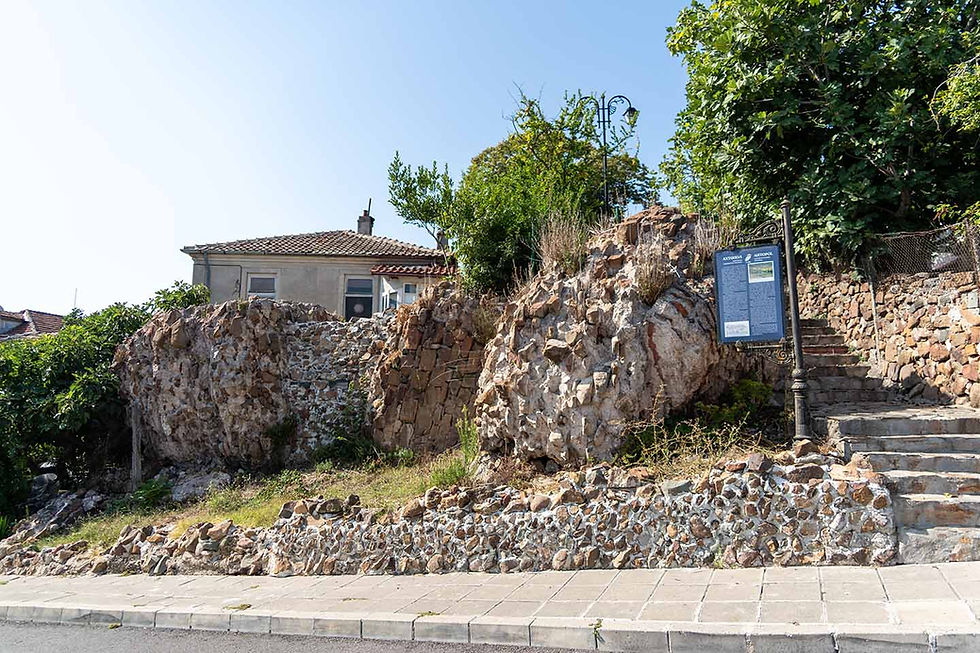
Prehistoric roots and the founding of Agathopolis
Evidence has also been found of the presence of the Thracian tribe of the Tini, who inhabited these lands during the Bronze Age and the Early Iron Ages, approximately between the 10th and 7th centuries BC. Among the finds from this period are stone axes and ceramic fragments, which give an idea of the lifestyle and culture of these early inhabitants.

Unlike many other ancient settlements that come and go, Ahtopol demonstrates remarkable continuity in its habitation. This long-standing presence, likely due to favorable natural conditions such as a convenient harbor and access to resources from the Strandzha Mountains, highlights the site’s resilience as a center of life and activity across different cultural periods. The multiple cultural layers dating from the 6th to the 1st centuries BC suggest enormous potential for future archaeological excavations. Such explorations could reveal even deeper layers of human history and shed light on the interactions between local Thracian tribes and the arriving Greek colonists, offering a unique insight into the cultural exchange in the region.
Around 430 BC, the town of Ahtopol was founded as a Greek colony by settlers from Athens.
Greek colonization and the emergence of Agathopolis
It is assumed that this foundation was directly related to the actions of Pericles in the Black Sea provinces, positioning the settlement as a strategic Athenian cleruchy.
The discovered archaeological monuments confirm that by the end of the 5th century BC an Athenian colony already existed here. The latest finds also categorically prove that Agathopolis was not only the medieval, but also the ancient name of the city.

The founding of Agathopolis was not simply a spontaneous settlement, but rather a deliberate political initiative by Athens to expand its influence and control over the trade routes and valuable resources of the Black Sea coast.
The establishment of the kleruchia was a direct consequence of this policy, aimed at providing grain, timber and other raw materials for the metropolis, as well as establishing a strategic military presence in the region. This political motivation explains the rapid development of the city as a commercial center. This early period is crucial, as it laid the foundations for Ahtopol's maritime identity and its integration into the wider Mediterranean and Black Sea trade network that would continue to shape its destiny in the centuries to come.
Agathopolis quickly established itself as a thriving commercial center. One of the most definitive indicators of its developed economy and a certain degree of autonomy is the fact that the city minted its own coins. The symbol of Ahtopol on these coins is the owl Agao, whose image appears on several issues of bronze coins.
Ahtopol in Antiquity and the Early Middle Ages
In the 2nd century, the city was colonized by the Romans, who gave it a new name - Peronticus. In the ancient periplus of Hadrian from 131 AD, the existence of the port of Auleuteichos is mentioned, which is probably an early name of the Ahtopol port, used before the Roman colonization.

By the mid-3rd century, the city was experiencing a period of economic decline. This decline was probably caused by a combination of factors, including Gothic invasions and a large-scale earthquake recorded in 262.
Barbarian invasions and the city's reconstruction by Agathon
After the devastating barbarian invasions that affected the region in the 5th–7th centuries, the city was rebuilt by the Byzantine general Agathon. As a sign of restoration and continuity with its ancient grandeur, Agathon renamed it Agathopol. In the late 5th and early 6th centuries, in response to the increased threats from the Great Migration of Peoples, Ahtopol was fortified with a powerful fortress wall.
Byzantium played a key role in the reconstruction and strengthening of the city, which shows its strategic importance for the Eastern Roman Empire as an important outpost.
After the barbarian invasions in the 5th – 7th centuries, the city was rebuilt by the Byzantine commander Agathon, who called it Agathopol. This event probably contributed to the establishment of the name and its association with goodness or happiness. The current name Ahtopol is derived from Agathopol. In historical sources, the city is also mentioned under other names such as Avleuteichos, Tirach, Perontikon, Agapipolis, Gastopoli and Ahtebol.
Ahtopol as a strategic point and border city
During the Middle Ages, Ahtopol was located on the border between the Bulgarian state and Byzantium, which made it the subject of frequent changes in possession. This constant change of control is a clear testimony to the exceptional strategic importance of the city.
The history of Ahtopol during the Middle Ages is closely connected with the rise and fall of the Bulgarian state.
Khan Krum conquered it in 812, and Tsar Todor Svetoslav in 1304. The city is mentioned as a conquered fortress on one of the columns in Pliska and was included in the 30-year peace treaty between Byzantium and Bulgaria during the time of Khan Omurtag in 815, remaining within Bulgarian borders until 971.
During the Middle Ages, Ahtopol established itself as an extremely important port, maintaining active trade relations with major centers such as Constantinople, Venice and Genoa.

This made it an important hub for international trade. Its port exported valuable goods, including timber for ships, copper from the rich deposits of Strandzha, dried meat, fish and honey.
In return, the city imported works of art, ceramics, tools, weapons and household items. The goods imported by sea were transported to the interior of Strandzha and as far as the cities of Eastern Thrace along a road laid along the Veleka River valley, which indicates the presence of a well-developed logistics network.
In addition to trade, Ahtopol also rose as an important religious center. Around 1389, twenty years after the capture of Edirne by the Ottomans, the Edirne Metropolitanate moved its seat to Agathopol. This act is an indicator of the city's growing spiritual authority and its relative security in uncertain times.
The history of Ahtopol during the Ottoman period was marked by significant changes and challenges.
Ottoman period and reconstruction
The town first fell under the Ottoman invaders in 1396, along with Sozopol and Midia. However, in 1403 Sultan Suleiman Çelebi returned it to Byzantium. The final fall under Ottoman rule occurred in the spring of 1453, simultaneously with the conquest of Constantinople and almost all the beautiful cities of the Black Sea coast.

At the beginning of the 20th century, Ahtopol was an important port city with a large fleet, owning 45 ships, three of which had a displacement between 1,000 and 3,000 tons. After the Balkan Wars (1912–1913), it was annexed to Bulgaria, its Greek population was deported and replaced with Bulgarian refugees from Eastern Thrace.
A fire in October 1918 destroyed almost the entire city, including the old Assumption Cathedral, and the modern city was rebuilt.
Late Antique and Medieval Fortress
Ahtopol's deep and continuous history, marked by changes of rule and cultural influences, makes it an extremely valuable object for studying the regional history of the Black Sea Coast. The fact that the city has experienced depopulation and complete destruction, but has nevertheless been rebuilt, emphasizes its resilience and strategic importance over the centuries. This is an indicator of the viability of the place, regardless of the vicissitudes of history.

A late antique and medieval fortress on the territory of today's Ahtopol is located on a small rocky peninsula jutting into the sea, with an area of about 5-6 acres. The territory of the fortress largely overlaps with the modern town of Ahtopol. This coincidence creates challenges for archaeological research, as many ruins are located under modern construction or street infrastructure, which makes access and conducting extensive excavations difficult.

The location of the fortress on a peninsula is a classic example of natural defenses that were further reinforced by human constructions. The fact that the modern city has developed on ancient and medieval foundations demonstrates the continuity of settlement life and the strategic attractiveness of the site over the millennia. However, this continuity poses a significant challenge for archaeology and conservation, as it requires a delicate balance between the needs of modern urban development and the preservation of valuable cultural heritage.

The main construction of the fortress walls and towers probably dates back to the late 5th century and early 6th century AD, during the time of Emperor Anastasius I (491 - 518).

Ancient Ahtopol was located on a small rocky peninsula, surrounded by a fortress wall along the entire coastline. The masonry is mixed - quarry stone with two faces and a filling of mortar and smaller stones, mixed with crushed tiles and bricks. The width of the walls varies: at the isthmus it is 2.80 meters (with a thickening up to 3.30 meters), and in the steep northeastern part - 1.50 to 2 meters.

In places the remains of the walls reach a height of 7-8 meters, although in other places they are preserved up to 3-4 meters. Three to five belts of bricks can be traced, alternating with stone rows.
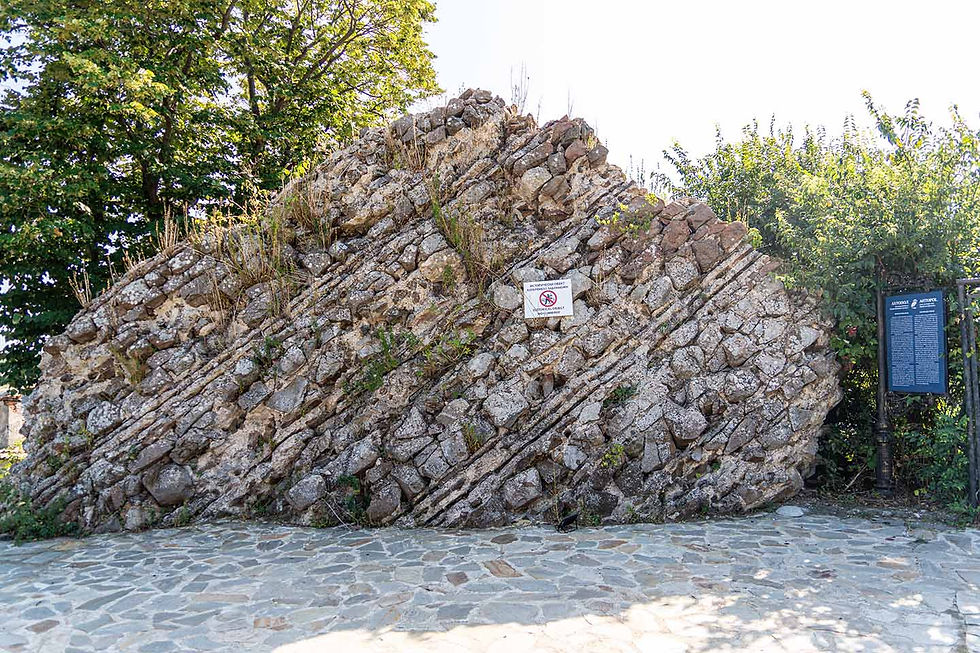
The main fortress defensive gate was located on the southwest side, flanked by two defensive battle fortress towers, about 12-14 meters high. So far, 7-8 towers have been identified with certainty: four on the southwest wall, three on the north and one on the narrow west side. The north gate was discovered in 2014, flanked by two rectangular towers. During the Middle Ages, the Bulgarians added two more towers on the inside of the curtain wall, mirroring the late antique ones, strengthening the defense of the northern entrance. For additional protection in front of the southwest main wall, there was a proteichism (outer wall), equipped with towers, and in front of it - a large ditch, traces of which can still be seen today. In the northernmost part of the peninsula, 100 meters in front of the north wall, an earthen rampart with a palisade was erected for additional protection from the sea.

The complex architecture of the Ahtopol Fortress, including multi-layered masonry, varying wall thicknesses, numerous towers, a proteichism, ditches and an earthen rampart, demonstrates a high level of fortification engineering and adaptation to various threats over the centuries. The presence of medieval Bulgarian additions highlights the active role of the Bulgarian rulers in maintaining and developing the city's defense system. This demonstrates that the fortress was not a static structure, but a dynamically developing military asset, reflecting the changing defense needs and priorities of different rulers.
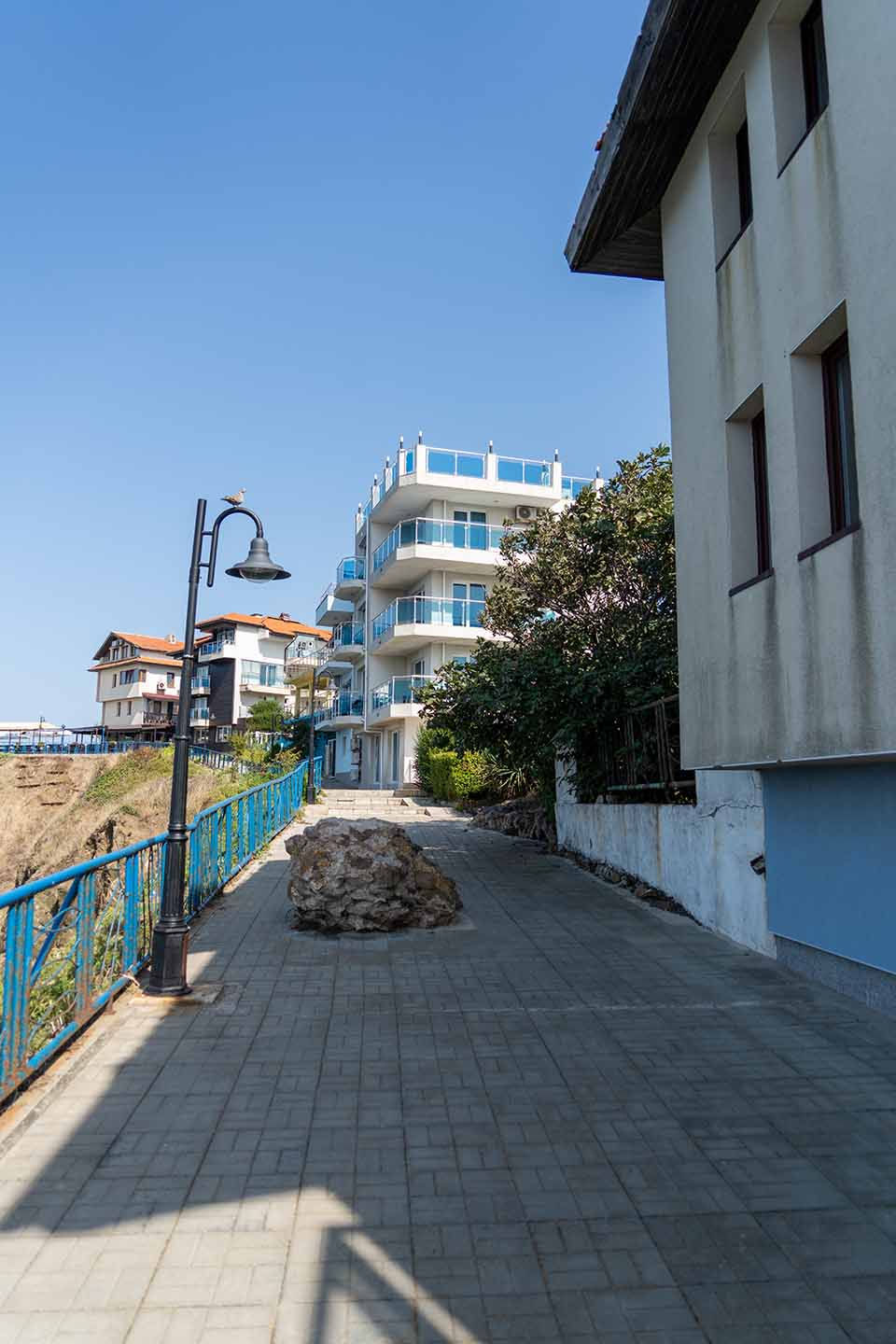
During the Middle Ages, the defensive walls were further strengthened, reaching a total width of 3.5 meters. It is assumed that the fortress was captured by the Ottoman conquerors in 1453 and burned down in the 17th century. However, archaeological evidence suggests that the actual destruction of the fortress was the result not so much of the Ottoman invasion, but of an earthquake in the first half of the 17th century.

The multiple changes of rule and construction phases at the Ahtopol Fortress, from Thracian foundations to medieval Bulgarian and Byzantine additions, not only show a long history, but also demonstrate the adaptability and continuous strategic importance of the site. Each new power invested in its fortification, which is evidence of its key role in regional geopolitics. Of particular importance is the fact that the significant destruction in the 17th century was caused by an earthquake, and not just by military actions. This explains the condition of the ruins today and complicates archaeological reconstruction, emphasizing the role of natural disasters in shaping historical landscapes.
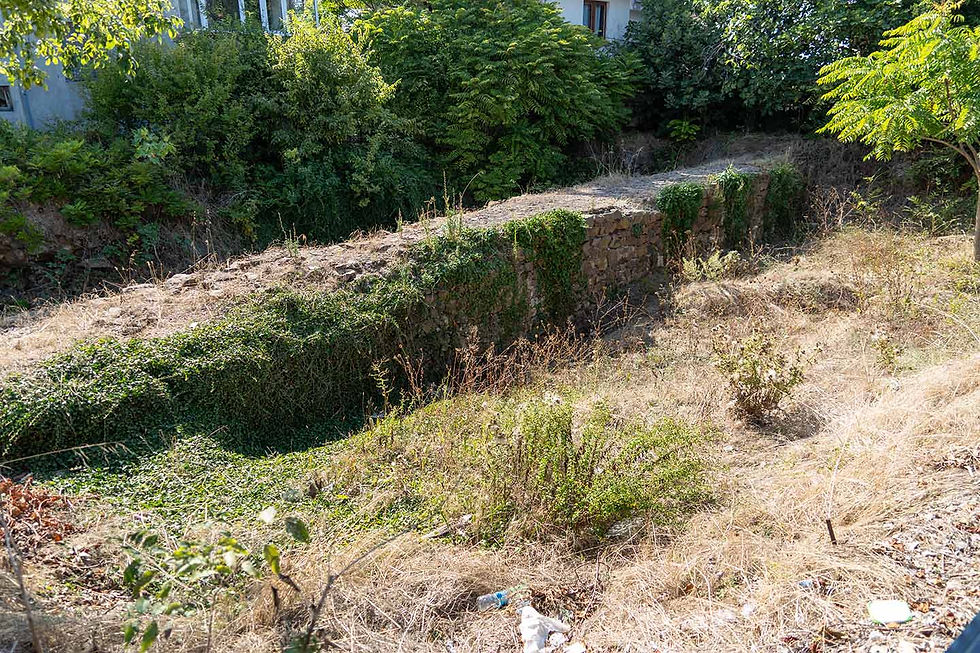
Ahtopol, or the ancient Agathopolis, is a city with a unique identity, formed by a rich etymology, mythological legends of love and happiness, and a thousand-year history. The nickname "city of love and happiness" is deeply rooted in both the linguistic origin of the name and the romantic myths of its founding.

The late antique and medieval fortress is a central element of this heritage, testifying to the city's continued strategic importance as a port, a commercial and religious center, and a contested border point between empires. Its multi-layered architecture and construction phases reflect the adaptability of fortification art and the importance that different rulers attached to its defense.

Archaeological research reveals a multi-layered history, from prehistoric settlements to key medieval fortifications. The discovery of the northern gate in 2014, with analogies in Pliska and Preslav, underscores Ahtopol's national significance for the First Bulgarian Kingdom, elevating it to the rank of an important historical center.

The fortress's status as a cultural monument of national importance, supported by projects such as CAST, demonstrates an active commitment to the preservation and promotion of this heritage. Despite the challenges posed by modern development and historical destruction, conservation efforts and improved access continue, transforming the fortress into a valuable resource for cultural tourism.
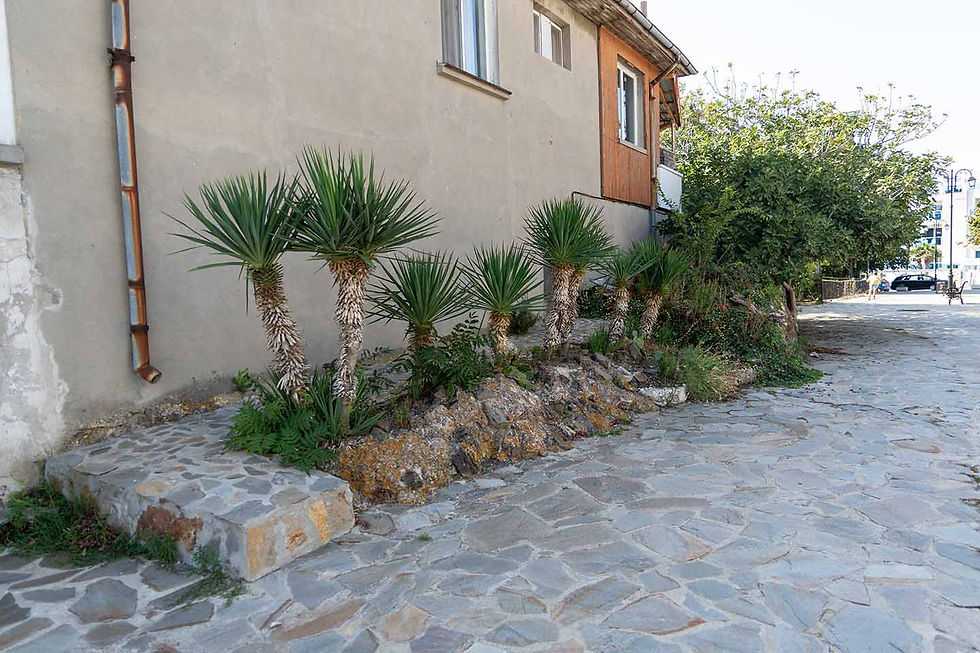
The Ahtopol Fortress is not just a set of ruins, but a living monument that tells the history of the region and Bulgaria through the centuries. It is a valuable source of information about the art of fortification, trade routes and political interactions in the Black Sea basin. Its preservation and promotion is of essential importance not only for scientific knowledge, but also for cultural tourism, education and the formation of a national identity. The Ahtopol Fortress is an example of how the past can be integrated into the present and contribute to the sustainable development of the community.
A late antique and medieval fortress in the town of Ahtopol has been declared an archaeological and architectural monument of culture from Antiquity and the Middle Ages with a category of national importance.
How to get to Ahtopol?
Ahtopol (Greek: Αγαθούπολιο) is a town on the southern Black Sea coast of Bulgaria, in the Tsarevo Municipality, Burgas District.
Uncover the thousand-year history of the seaside town and visit its hidden treasures HERE.
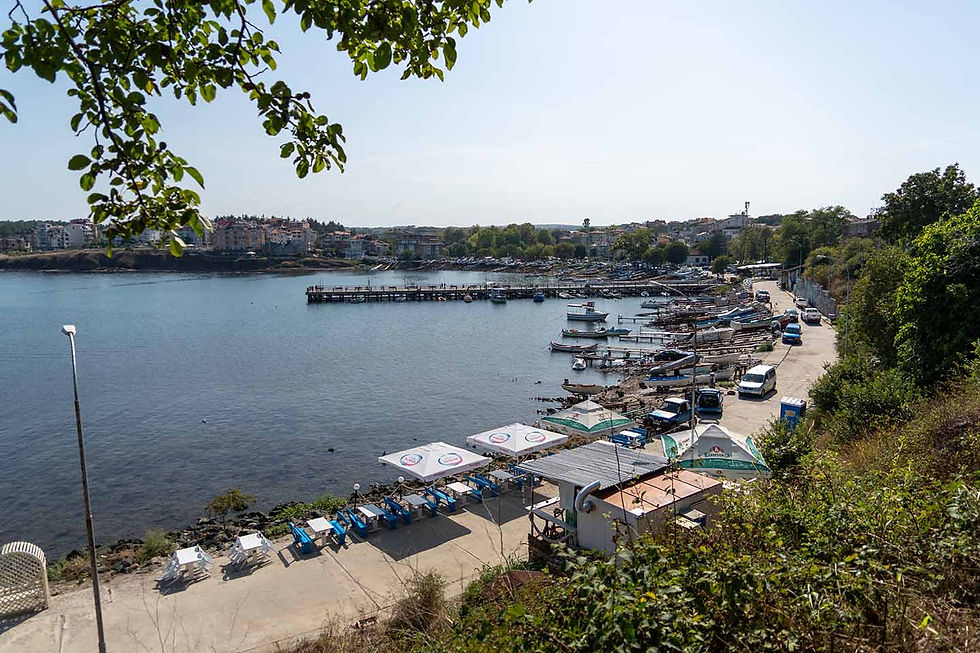
The third-class republican road III-9901 passes through Ahtopol, which leads northwest through the village of Varvara to a connection near the town of Tsarevo with the second-class republican road II-99 and along it to Burgas, and southeast through the village of Sinemorets it leads to the village of Rezovo, where it ends.

There is no air transport in Ahtopol. The nearest airport is Burgas Airport.
Ahtopol is located:
460 kilometers (about 4 hours and 44 minutes by car) from the capital
328 kilometers (about 3 hours and 34 minutes by car) from the city of Plovdiv
207 kilometers (about 3 hours and 17 minutes by car) from the city of Varna
77 kilometers (about 1 hour and 09 minutes by car) from the city of Burgas
Ahtopol is located about 15 kilometers (about 18 minutes by car) southeast of the municipal center of Tsarevo and about 17 kilometers (about 21 minutes by car) north-northwest of the southernmost Bulgarian settlement on the Black Sea - the village of Rezovo, near which the state border with the Republic of Turkey passes.
The city is located on an abrasion terrace on a rocky peninsula between Cape Ahtopol and Cape Sveti Yani.
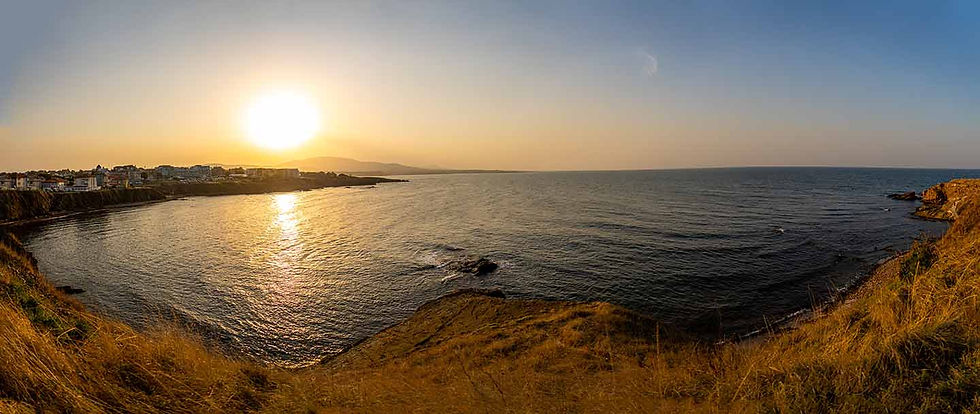
To the west, right next to the city, the branches of the Strandzha hill Bosna reach, with the highest peak Papija (501.4 meters).

About four kilometers to the south, near the village of Sinemorets, is the mouth of the Veleka River.

The altitude in the city at the "Holy Assumption of the Virgin Mary" church, which rises directly opposite the port, is about 10 meters, in the southwest it increases to about 30 - 35 meters.

I tell you about the Church of the Assumption of the Virgin Mary in Ahtopol HERE.
The climate is continental-Mediterranean with a strong Black Sea climatic influence - mild winters - the mildest winter in Bulgaria, hot summers, early spring and a long and warm autumn.

Ahtopol has a humid subtropical climate (Köppen climate classification) bordering on a Mediterranean climate with limited continental effect.
Ahtopol is a seaside resort with hotels, holiday villages and bungalows, located mainly in the Korosiata area, west of the city, restaurants, numerous guest houses, entertainment venues and campsites.
The beach near the Korosiata area, called the Central Beach of Ahtopol, is with fine sand and dunes, wide, with a length in the territory of Ahtopol of about 1400 meters, and together with the beach, continuing to the northwest in the territory of the village of Varvara - a total of about two kilometers. The coastal seabed is shallow.
In addition to the central beach, there are a series of small beaches in the territory of Ahtopol.
The city is within the territorial scope of Strandzha Nature Park.

In the northern part of the port of Ahtopol stands the Ahtopol Lighthouse - the white guard of the port.
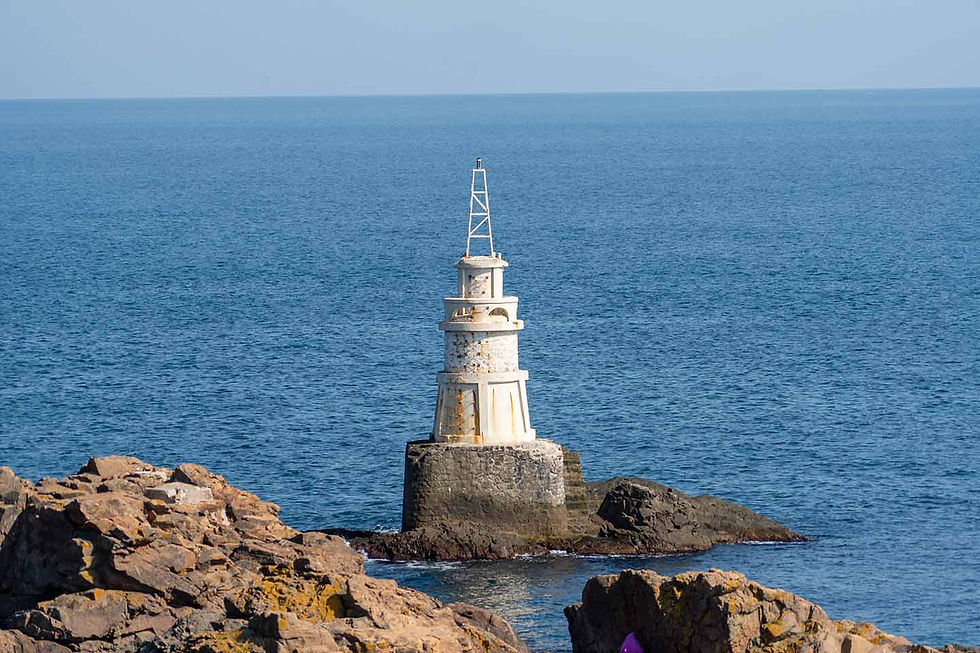
I tell you about the Ahtopol Lighthouse – the white guard of the port HERE.
On the site of today's city of Ahtopol, settlements have existed since the Neolithic Age, and during the Iron Age the region was inhabited by the Thracian tribe of Tini.
As a city, Ahtopol was founded around 430 BC by Greek colonists from Athens, and it is assumed that its founding is related to the actions of Pericles in the Black Sea regions.

The city became a trading center, with coins being minted there.
After the barbarian invasions of the 5th - 7th centuries, the city was rebuilt by the Byzantine commander Agathon, who called it Agathopol.
During the Middle Ages, Agatopolis was included in the territory of Bulgaria several times.
I tell you about the late antique and medieval fortress in Ahtopol – the city of love and happiness Agatopolis HERE.

You can see the fully preserved church "Holy Ascension of the Lord", built in 1776, remains of the monastery "St. John" (St. Yani) from the 12th century, as well as parts of the defensive fortress wall that surrounded the city's citadel, built by Thracians, Romans and Bulgarians, ruins of which can now be seen throughout Ahtopol.
I tell you about the temple monument "Holy Ascension of the Lord" - one of the oldest and most significant architectural monuments in Ahtopol HERE.
The rich historical past of the region is told by the priceless exhibits displayed in the building of the old Greek school, which has today been converted into a museum, as well as the extremely interesting museum collection of the Public Collection "Anchor Museum" in Ahtopol - an immersion in the thousand-year-old maritime tradition with a great love for the sea.
I tell you about the Public Collection "Anchor Museum" in Ahtopol - an immersion in the thousand-year-old maritime tradition with a great love for the sea HERE.
I tell you about the Old Greek School in Ahtopol - a creative base of the National Academy of Arts, a remarkable example of a cultural and historical monument and a center for art and heritage HERE.
How do you get to the fortress wall?
Today, fragments of the fortress walls can be seen literally everywhere in Ahtopol.
You are reading an ad-free blog – fully focused on the content!
I remind you that you can read all my posts here – in "Photo Moments", without being interrupted by a single annoying ad, because "Photo Moments" is a place without ads!
I made the important decision to make "Photo Moments" ad-free so that my site can load much faster, the content I present to you can be as clean as possible, and your experience in "Photo Moments" can be the best possible!
If you appreciate everything I do, you can support me HERE or by following the gold star below.
Thank you!
And finally, my dear friends,
you shouldn't miss checking out
the special photo album with moments –
discovered, experienced, filmed and shared with you!





























































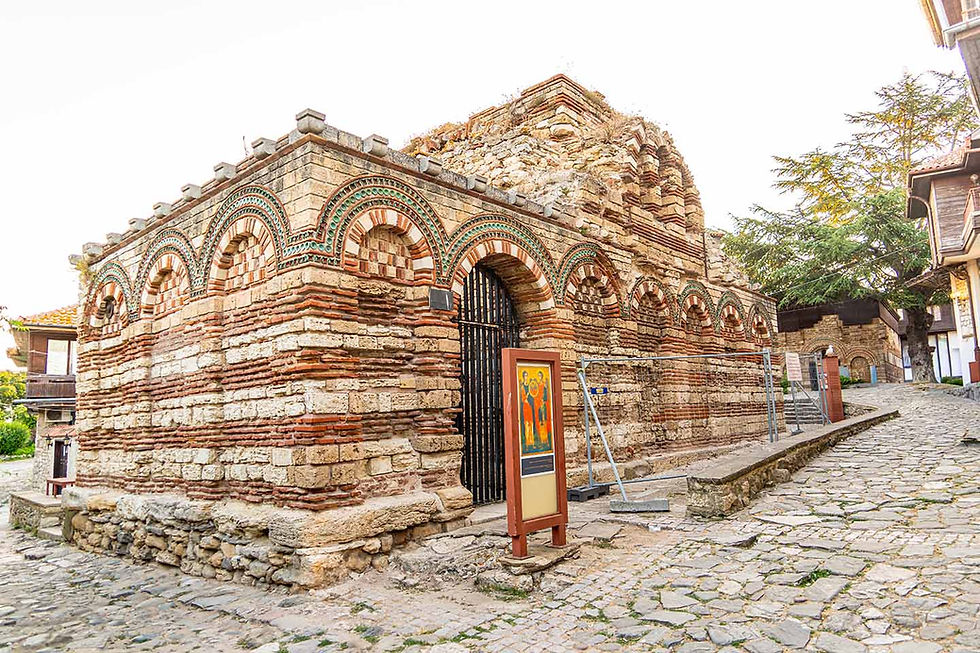
Comments